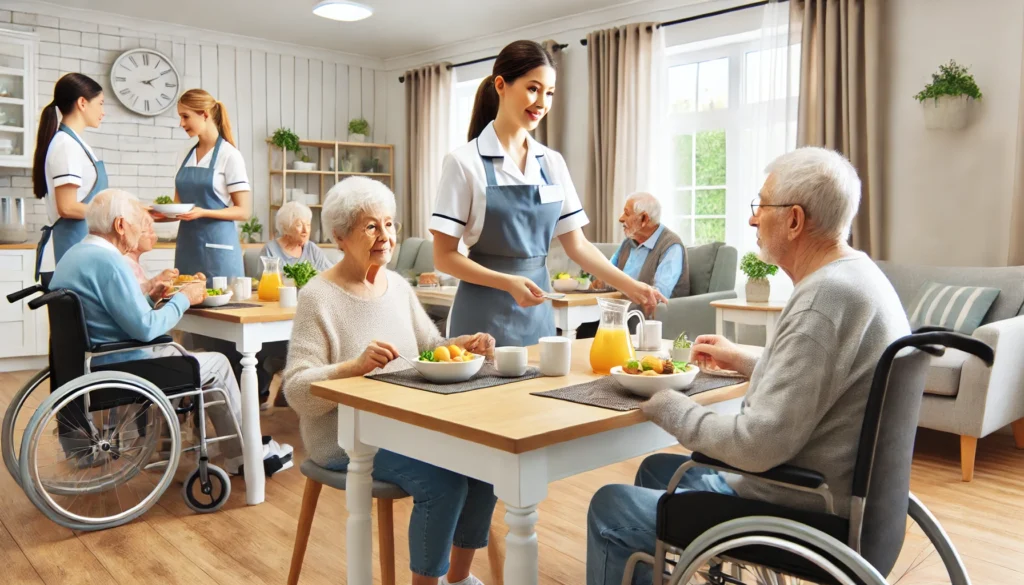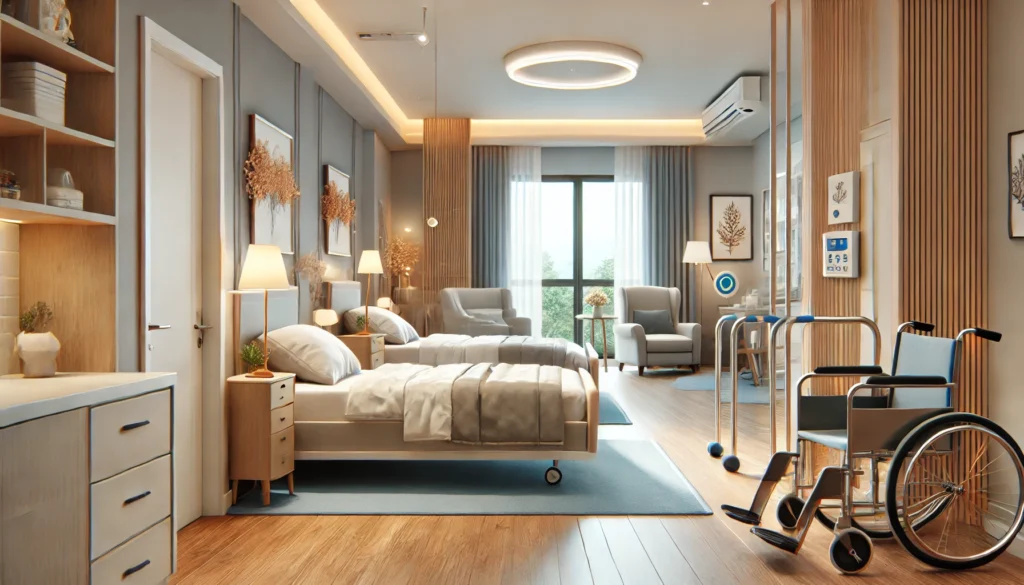Elderly care homes, also known as aged care facilities or assisted living facilities, provide a sanctuary where older adults receive the assistance they need while maintaining a degree of independence. These facilities vary in terms of services offered, ranging from basic assistance with daily activities to comprehensive medical care.
You may also like: Finding Local Specialists for Memory Loss
The Role of Elderly Care Homes
Elderly care homes play a pivotal role in supporting the aging population. They offer not just a place to live but a community where seniors can thrive. These homes bridge the gap between complete independence and the need for care, addressing both physical and emotional needs. By providing a supportive environment, they can significantly enhance the quality of life for residents.
Differences Between Facility Types
Understanding the differences between various types of facilities is essential. Independent Living Communities, for example, focus more on offering amenities and social opportunities, while Assisted Living Facilities provide necessary daily assistance. Nursing Homes cater to those with significant medical needs, offering around-the-clock care. Meanwhile, Memory Care Units are specialized for residents with cognitive impairments, such as Alzheimer’s. Recognizing these distinctions can help families align personal needs with what each facility offers.
The Importance of Environment and Culture
The environment and culture of a care home are crucial factors that impact residents’ well-being. A welcoming, warm environment with a positive culture fosters a sense of belonging and community. It’s important to consider the overall vibe and ethos of the facility, as this can greatly influence a resident’s happiness and comfort. A nurturing environment often translates to better mental and emotional health for seniors.
Key Considerations for Choosing a Care Facility
Selecting the right care facility involves evaluating various factors to ensure it meets the specific needs of the resident.
Location and Accessibility
The location of a care home is more than just a geographical preference; it impacts the frequency and ease of visits from family and friends. Proximity to familiar places can ease the transition for new residents. Moreover, accessibility to nearby hospitals and emergency services is vital for swift medical responses when needed. Additionally, consider the ease of access to recreational areas or parks, which can enhance the quality of life for residents who enjoy outdoor activities.
Services and Amenities
A wide array of services and amenities can significantly enrich the living experience within a care facility.
- Housekeeping and Maintenance: Regular cleaning and maintenance services ensure a clean, safe living environment, contributing to residents’ physical and mental well-being.
- Culinary Options: Diverse meal plans with dietary accommodations cater to various health needs and cultural preferences, playing a crucial role in overall health and happiness.
- Recreational Activities: Social and recreational activities not only provide entertainment but also foster social connections, reducing feelings of isolation.
- Transportation Services: Reliable transportation services enable residents to maintain independence and engagement with the larger community.
- Wellness Programs: Health and wellness programs, including fitness classes and health screenings, promote physical health and longevity, enhancing the overall quality of life.
Staff Qualifications and Ratios
The competence and care provided by staff are fundamental to the quality of any care facility.
- Training and Certification: Ensure staff have relevant qualifications and participate in ongoing training to stay updated on best care practices.
- Staff-to-Resident Ratios: A lower ratio allows for more personalized care, ensuring each resident receives attention and support tailored to their needs.
- Staff Interactions and Attitude: Observing how staff interact with residents can provide insights into the facility’s culture and the level of care provided. Compassionate, respectful staff contribute to a positive living environment.

Safety and Security Measures
Safety is a non-negotiable aspect of elderly care, encompassing various elements.
- Emergency Protocols: Evaluate the facility’s emergency response systems, including fire safety measures and medical emergency protocols, to ensure resident safety.
- Security Measures: Security features, such as surveillance cameras and secure entrances, protect residents and provide peace of mind to families.
- Fall Prevention Strategies: Implementing strategies to prevent falls, such as handrails and non-slip flooring, is crucial, as falls can lead to serious injuries in seniors.
- Health Safety Protocols: In light of recent global health concerns, inquire about COVID-19 safety measures and infection control practices to ensure a safe environment.
Costs and Financial Considerations
Understanding the financial implications of choosing a care home is crucial for long-term planning.
- Monthly Fees and Inclusions: Clarify what is included in the monthly fees, such as meals, accommodation, and basic care services, to avoid hidden costs.
- Additional Services and Fees: Determine any extra costs for specialized services, such as physical therapy or memory care, which might not be covered in the standard fees.
- Insurance and Financial Aid Options: Explore potential financial support through Medicare, Medicaid, or long-term care insurance to help manage expenses. Financial planning is essential to ensure the chosen care home remains sustainable over time.
Future Trends in Elderly Care
The elderly care industry is evolving, with new trends enhancing the quality and accessibility of care.
Technological Integration
Technology is revolutionizing elderly care, offering numerous benefits.
- Telemedicine: Telehealth services enable remote consultations, making healthcare more accessible and convenient for residents.
- Wearable Health Devices: These devices monitor vital signs and activity levels, providing real-time data that can prevent health crises.
- AI and Automation: AI-driven solutions are improving care delivery, enhancing safety and efficiency through predictive analytics and automated monitoring systems.
Person-Centered Care Models
Person-centered care is gaining traction, emphasizing personalized care plans.
- Individualized Care Plans: Facilities are increasingly customizing care plans based on residents’ unique preferences, needs, and histories, leading to more fulfilling experiences.
- Resident Empowerment: Empowering residents to make choices about their daily activities and care fosters a sense of control and dignity.
- Family Involvement: Encouraging family involvement in care planning ensures that residents’ values and desires are respected and integrated into their care.

Sustainable and Eco-Friendly Facilities
Environmental consciousness is influencing the design and operation of care homes.
- Green Building Practices: Sustainable building materials and energy-efficient systems reduce the environmental impact of facilities.
- Eco-Friendly Operations: Implementing recycling programs and reducing waste promotes sustainability and can contribute to a healthier living environment.
- Healthier Living Spaces: Eco-friendly practices, such as using non-toxic materials and enhancing natural light, create healthier, more comfortable living spaces for residents.
Practical Tips for Making the Decision
Making a well-informed decision requires a thorough evaluation process.
Visit Multiple Facilities
Visiting several facilities offers invaluable insights.
- Observe Interactions: Pay attention to how staff and residents interact, as this reflects the facility’s culture and atmosphere.
- Assess Cleanliness and Maintenance: A well-maintained facility is indicative of quality care and attention to detail.
- Experience the Environment: Take note of the overall environment and amenities, ensuring they align with the resident’s needs and preferences.
Talk to Residents and Families
Engaging with current residents and their families provides firsthand accounts of life at the facility.
- Gather Honest Feedback: Residents and families can offer candid insights into the facility’s strengths and areas for improvement.
- Understand Resident Satisfaction: High levels of resident satisfaction often correlate with a supportive, nurturing environment.
- Learn About Transition Experiences: Understanding how other residents adapted to the facility can inform expectations and ease the transition process.
Review Accreditation and Licensing
Ensuring the facility meets regulatory standards is essential for quality assurance.
- Verify Compliance: Check that the facility complies with state regulations and holds necessary accreditations, which reflect adherence to industry standards.
- Examine Inspection Reports: Reviewing past inspection reports can reveal any issues or violations, providing a clearer picture of the facility’s operations.
- Consider Industry Ratings: Independent ratings and reviews can offer additional perspectives on the facility’s performance and reputation.
Trust Your Instincts
Ultimately, your instincts play a crucial role in the decision-making process.
- Assess Comfort Level: Trust your feelings about the facility’s atmosphere and whether it feels welcoming and comfortable.
- Evaluate Staff Dedication: Consider the staff’s commitment to care, as their dedication directly impacts residents’ experiences.
- Ensure Alignment with Values: The facility should align with the resident’s values and lifestyle preferences, ensuring a harmonious living arrangement.

Conclusion
Choosing the right elderly care home is a journey that requires careful consideration of personal needs, facility offerings, and future trends. By taking the time to research and evaluate options, you can make an informed decision that prioritizes well-being, safety, and a fulfilling quality of life. The landscape of elderly care is ever-evolving, and with the right choice, it can be a source of comfort and peace of mind for both residents and their families.
Further Reading:
8 Types of Senior Care & Living Options
Compassionate In-Home Senior Care
Different Types of Eldercare & Care Homes
Important Note: The information contained in this article is for general informational purposes only, and should not be construed as health or medical advice, nor is it intended to diagnose, prevent, treat, or cure any disease or health condition. Before embarking on any diet, fitness regimen, or program of nutritional supplementation, it is advisable to consult your healthcare professional in order to determine its safety and probable efficacy in terms of your individual state of health.
Regarding Nutritional Supplements Or Other Non-Prescription Health Products: If any nutritional supplements or other non-prescription health products are mentioned in the foregoing article, any claims or statements made about them have not been evaluated by the U.S. Food and Drug Administration, and such nutritional supplements or other health products are not intended to diagnose, treat, cure, or prevent any disease.


